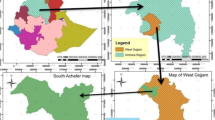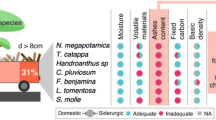Abstract
Smallholders who own Tectona grandis plantations receive limited profit from residues. Charcoal production from wood residues allows smallholders to become part of the commercial chain. The purpose of this study was to examine the process of making charcoal from T. grandis wood residues using the earth pit method, as well as the costs and economic potential along with the physical, energy, mechanical, and chemical characteristics of the charcoal produced using this technique. Lumber in green condition (L-G), non-commercial logs in green condition (NL-G), and non-commercial logs in air-dried condition (NL-A) were utilized to produce charcoal. The charcoal recovery yield obtained from NL-A was 24%, with a carbonization time of 4.3 days, while for the NL-G and NL-A conditions, the recovery yield varied from 8 to 14.5%. The investment cost was US$1247 and the production cost was US$0.71/kg. The estimated total annual production is 11470 kg of charcoal, with annual profits of US$4863.3/year. The charcoal presented moisture content between 4.16 and 6.13%; density between 0.27 and 0.47 g/cm3; a calorific value between 31.3 and 32.6 MJ/kg; ash content between 1.5 and 3.3%; volatile content between 9.4 and 18.7%; fixed carbon content between 73.3 and 80.1% and the maximum compressive strength was about 120–132 kg. Statistical differences were found in carbon, fixed carbon content, nitrogen (N) and potassium (K) contents. The charcoal produced from NL-G raw material presents less quality than the charcoal from NL-A and L-G. This is because it presents less proportion of fixed carbon content. Finally, the results indicate the possibilities for smallholders to produce charcoal.




Similar content being viewed by others
Data availability
The datasets used during the current work are available from the corresponding author request and in the Knowledge Network for Biocomplexity (KNB).
References
Adam JC (2009) Improved and more environmentally friendly charcoal production system using a low-cost retort-kiln (eco-charcoal). Renew Energy 34(8):1923–1925. https://doi.org/10.1016/j.renene.2008.12.009
Aller MF (2016) Biochar properties: transport, fate, and impact. Crit Rev Environ Sci Technol 46:1183–1296. https://doi.org/10.1080/10643389.2016.1212368
ASTM (2016a). Standard test methods for direct moisture content measurement of wood and wood-based materials. American Society For Testing and Materials (ASTM) D4442. Annual Book of ASTM Standards. vol 4.10 (Woods), West Conshohocken
ASTM (2016b). Standard methods of testing small clear specimens of timber. American Society For Testing and Materials (ASTM) D-142-84. Annual Book of ASTM Standards. vol 4.10 (Woods), pp. 149–149. West Conshohocken
ASTM. (2017). Standard test method for proximate analysis of coal and coke. American Society For Testing and Materials (ASTM) D3173/D3173M-17a Annual Book of ASTM Standards. vol 4.10 (Woods). American Society For Testing and Materials, West Conshohocken
ASTM (2019) Standard Test method for gross calorific value of coal and coke. American Society For Testing and Materials (ASTM) D5865/D5865M-19 Annual Book of ASTM Standards. vol 4.10 (Woods). American Society For Testing and Materials, West Conshohocken
ASTM (2021) Standard test method for chemical analysis of wood charcoal. American Society For Testing and Materials (ASTM) D- 1762–84 Annual Book of ASTM Standards. Volume 4.10 (Woods). American Society For Testing and Materials, West Conshohocken
Balaguer-Benlliure V, Moya R, Gaitan-Alvarez J (2022) Physical and energy characteristics, compression strength and chemical modification of charcoal produced from sixteen tropical woods in Costa Rica. J Sustain for. https://doi.org/10.1080/10549811.2021.1978096
Brewer CE, Brown RC (2012). Biochar. In: comprehensive renewable energy, pp 357–384. https://doi.org/10.1016/B978-0-08-087872-0.00524-2
Brown R (2009) Biochar production technology. In: Lehmann J, Joseph S (eds) Biochar for environmental management: science and technology. Wiley, Chichester, pp 127–146. https://doi.org/10.4324/9781849770552-15
Bustamante-García V, Carrillo-Parra A, González-Rodríguez H, Garza-Ocañas F, Prieto-Ruiz J, Corral-Rivas JJ, Vega-Nieva DJ (2014) Tecnologías para la transformación de la biomasa en carbón vegetal. Capitulo 7, pp 142–165. In: Garza F, Guevara JA, Vilalón H, Carrillo A (eds) Técnicas en el manejo sustentable de Recursos naturales. Universida autónoma de Nuevo León. Facultad de Ciencias Forestal. Monterrey, Mexico.
Camou-Guerrero A, Ghilardi A, Mwampamba T, Avila TO, Vega E, Oyama K, Masera O (2014) Análisis de la producción de carbón vegetal en la Cuenca del Lago de Cuitzeo, Michoacán, México: implicaciones para una producción sustentable. Investigación Ambiental 6(2):127–138
Camps Arbestain M, Amonette J, Singh B, Wang T, Schmidt HP (2015) A biochar classification system and associated test methods. In Johannes Lehmann SJ (ed) Biochar for environmental management Routledge, pp 165–194
CATIE (2018). Producciòn de carbón vegetal en la Estrella de El Guarco, Cartago, Costa Rica. Centro Agronómico Tropical de Investigación y Enseñanza (CATIE) Informe Tecnico. Turrialba, Costa Rica.
Cha JS, Park SH, Jung SC, Ryu C, Jeon JK, Shin MC, Park YK (2016) Production and utilization of biochar: a review. J Ind Eng Chem 40:1–15. https://doi.org/10.1016/j.jiec.2016.06.002
Coomes OT, Miltner BC (2017) Indigenous charcoal and biochar production: potential for soil improvement under shifting cultivation systems. Land Degrad Dev 28(3):811–821. https://doi.org/10.1002/ldr.2500
Cuthbertson D, Berardi U, Briens C, Berruti F (2019) Biochar from residual biomass as a concrete filler for improved thermal and acoustic properties. Biomass Bioenerg 120:77–83. https://doi.org/10.1016/j.biombioe.2018.11.007
Duku MH, Gu S, Hagan EB (2011) Biochar production potential in Ghana—a review. Renew Sustain Energy Rev 15(8):3539–3551. https://doi.org/10.1016/j.rser.2011.05.010
Espinoza-Durán J, Moya R (2013) Logging and industrialization of two gmelina arborea plantations with different degrees of slopes. Revista Chapingo, Serie Ciencias Forestales y Del Ambiente. https://doi.org/10.5154/r.rchscfa.2011.09.067
FAO, Food and Agriculture Organization of the Nations (1983) Simple technologies for charcoal making. In Simple technologies for charcoal making. FAO Forestry Paper (FAO). no. 41. Retrieved from http://www.fao.org/3/X5328e/X5328e00.htm
Gaitan-Alvarez J, Moya R, Berrocal A (2019) The use of X-ray densitometry to evaluate the wood density profile of Tectona grandis trees growing in fast-growth plantations. Dendrochronologia 55:71–79. https://doi.org/10.1016/j.dendro.2019.04.004
Hecht SB (2014) Forests lost and found in tropical Latin America: the woodland green revolution. J Peasant Stud 41(5):877–909. https://doi.org/10.1080/03066150.2014.917371
Jayawardhane JKPC, Perera PKP, Lokupitiya RS, Amarasekara HS, Lokupitiya RS, Ruwanpathirana N (2016) The effect of quality attributes in determination of price for plantation-grown teak (Tectona grandis) logs in Sri Lanka. Ann for Res 59(1):105–116. https://doi.org/10.15287/afr.2015.441
Kim M, Park J, Yu S, Ryu C, Park J (2019) Clean and energy-efficient mass production of biochar by process integration: evaluation of process concept. Chem Eng J 355:840–849. https://doi.org/10.1016/j.cej.2018.08.177
Klasson KT (2017) Biochar characterization and a method for estimating biochar quality from proximate analysis results. Biomass Bioenerg 96:50–58. https://doi.org/10.1016/j.biombioe.2016.10.011
Kollert W, Kleine M (2017) The global teak study analysis, evaluation and future potential of teak resources. IUFRO World Series Win, Austria, p 99
Lansing DM (2017) Understanding smallholder participation in payments for ecosystem services: the case of Costa Rica. Hum Ecol 45(1):77–87. https://doi.org/10.1007/s10745-016-9886-x
Luoga EJ, Witkowski ET, Balkwill K (2000) Economics of charcoal production in miombo woodlands of eastern Tanzania: some hidden costs associated with commercialization of the resources. Ecol Econ 35(2):243–257. https://doi.org/10.1016/S0921-8009(00)00196-8
Manzón-Che MJ (2015) Evaluación del impacto socioeconómico de la producción del carbón vegetal en una comunidad forestal en la Península de Yucatán, México (CATIE (Centro Agronómico Tropical de Investigación y Enseñanza)). In: Master Science Thesis. Retrieved from http://repositorio.bibliotecaorton.catie.ac.cr/handle/11554/8517?show=full
Ministerio de Trabajo (2019) Decreto No 41434-MTSS “Salarios mínimos” (p 112). p 112. Gobierno de Costa Rica. Retrieved from http://www.mtss.go.cr/temas-laborales/salarios/decretos/Decreto_salarios_2019.pdf
Mohr SH, Evans GM (2009) Forecasting coal production until 2100. Fuel 88(11):2059–2067. https://doi.org/10.1016/j.fuel.2009.01.032
Moya R, Pérez D (2007) Processing and marking of teakwood products from fast-grown teak plantations in Costa Rica. In: Nair AV, Bhat KV (eds) Abstracts regional workshop products and marketing of teak wood products of planted forest. Peechi, India, pp 117–125
Moya R, Solera J, Guerrero R, Bolooni K (2013) Comercialización de la teca. In: De Camino R, Morales JP (eds) Las plantaciones de teca en América Latina: Mitos y realidades (pp 225–244). Turrialba Costa Rica: Serie Técnica Informe Técnico/CATIE no. 397
Mwampamba TH, Owen M, Pigaht M (2013) Opportunities, challenges and way forward for the charcoal briquette industry in Sub-Saharan Africa. Energy Sustain Dev 17(2):158–170. https://doi.org/10.1016/j.esd.2012.10.006
Nölte A, Meilby H, Yousefpour R (2018) Multi-purpose forest management in the tropics: Incorporating values of carbon, biodiversity and timber in managing Tectona grandis (teak) plantations in Costa Rica. For Ecol Manag 422:345–357. https://doi.org/10.1016/j.foreco.2018.04.036
Novak JM, Moore E, Spokas KA, Hall K, Williams A (2019). Future biochar research directions. In: Biochar from Biomass and Waste, pp 423–435 https://doi.org/10.1016/B978-0-12-811729-3.00022-4
Panwar NL, Pawar A, Salvi BL (2019) Comprehensive review on production and utilization of biochar. SN Appl Sci 1(2):168. https://doi.org/10.1007/s42452-019-0172-6
Perdana A, Roshetko JM (2016) Survival strategy: traders of smallholder teak in Indonesia. Int for Rev 17(4):461–468. https://doi.org/10.1505/146554815817476477
Powlen KA, Jones KW (2019) Identifying the determinants of and barriers to landowner participation in reforestation in Costa Rica. Land Use Policy 84:216–225. https://doi.org/10.1016/j.landusepol.2019.02.021
Qian K, Kumar A, Zhang H, Bellmer D, Huhnke R (2015) Recent advances in utilization of biochar. Renew Sustain Energy Rev 42:1055–1064. https://doi.org/10.1016/j.rser.2014.10.074
Rodrigues T, Braghini A (2019) Technological prospecting in the production of charcoal: a patent study. Renew Sustain Energy Rev 111:170–183. https://doi.org/10.1016/j.rser.2019.04.080
Serrano R, Moya R (2011) Procesamiento, uso y mercado de la madera en Costa Rica: aspectos históricos y análisis crítico. Revista Forestal Mesoamericana Kurú 8(21): 1–12. Retrieved from https://revistas.tec.ac.cr/index.php/kuru/article/view/370
Singh B, Singh BP, Cowie AL (2010) Characterisation and evaluation of biochars for their application as a soil amendment. Soil Res 48(7):516. https://doi.org/10.1071/SR10058
Snyder BF (2019) Costs of biomass pyrolysis as a negative emission technology: a case study. Int J Energy Res 43(3):1232–1244. https://doi.org/10.1002/er.4361
Tripathi M, Sahu JN, Ganesan P (2016) Effect of process parameters on production of biochar from biomass waste through pyrolysis: a review. Renew Sustain Energy Rev 55:467–481. https://doi.org/10.1016/j.rser.2015.10.122
Ugalde L (2013) Teak: new trends in silviculture: commercialization and wood production. International Forestry and Agroforestry, Cartago, p 552
Xie T, Reddy KR, Wang C, Yargicoglu E, Spokas K (2015) Characteristics and applications of biochar for environmental remediation: a review. Crit Rev Environ Sci Technol 45(9):939–969. https://doi.org/10.1080/10643389.2014.924180
Yargicoglu EN, Sadasivam BY, Reddy KR, Spokas K (2015) Physical and chemical characterization of waste wood derived biochars. Waste Manag 36:256–268. https://doi.org/10.1016/j.wasman.2014.10.029
Acknowledgements
The authors are grateful for the support of the Vicerrectoría de Investigación y Extensión of the Instituto Tecnológico de Costa Rica and of EcoBosques S.A., who contributed the materials for this research.
Funding
Funding was provided by Vicerrectoría de Investigación y Extensión of the Instituto Tecnológico de Costa Rica, Cartago, Costa Rica.
Author information
Authors and Affiliations
Contributions
NB-M contributed with fabricated the charcoal and charcoal material sampling, determination of properties and running the data analysis. RM contributed with the designing of the experiment, tree sampling, writing the paper, and coordinating the research project.
Corresponding author
Ethics declarations
Conflict of interest
The authors declare that they have no conflict of interest.
Additional information
Publisher's Note
Springer Nature remains neutral with regard to jurisdictional claims in published maps and institutional affiliations.
Rights and permissions
Springer Nature or its licensor holds exclusive rights to this article under a publishing agreement with the author(s) or other rightsholder(s); author self-archiving of the accepted manuscript version of this article is solely governed by the terms of such publishing agreement and applicable law.
About this article
Cite this article
Berrocal-Mendéz, N., Moya, R. Production, cost and properties of charcoal produced after logging and sawing, by the earth pit method from Tectona grandis wood residues. J Indian Acad Wood Sci 19, 121–132 (2022). https://doi.org/10.1007/s13196-022-00301-y
Received:
Accepted:
Published:
Issue Date:
DOI: https://doi.org/10.1007/s13196-022-00301-y




